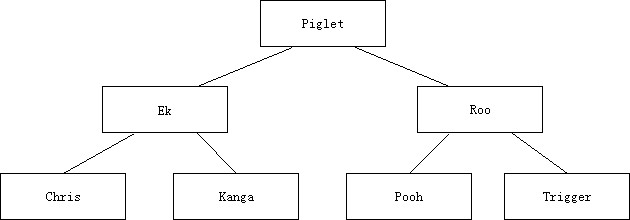这一章通过讲解二叉树的template的实现过程,来讲解template的语法,以及一些需要注意的地方。
首先了解一下二叉树的一些基本操作,二叉树支持插入,删除,遍历的操作。第一个安插至空白树的值,会成为此树的根节点。接下来的每个节点按特定的规则插入。如果小于根节点,就被置于左侧指数,大于根节点就被置于右子树。string类型按照字典排序。如下图

遍历又分前序遍历,中序遍历,后序遍历。
按照上图,前序遍历结果: Piglet,Ek,Chris,Kanga,Roo,Pooh,Trigger.
中序遍历结果:Chris Ek Kanga Piglet Pooh Roo Trigger
后序遍历结果:Chris Kanga Ek Pooh Trigger Roo Piglet
下面先实现一个节点类型BTnode。如果不实现泛型,
- class string_node {
- public:
- private:
- string _val; //节点的值
- int _cnt; //节点计数
- string_node *_lchild; //左节点
- string_node *_rchild; //右节点
- };
如果要实现存储int类型的节点则又要定义一个int_node类。这显然太麻烦。我们可以定义一个支持泛型的节点。
- template<typename valType>
- class BTnode {
- friend class BinaryTree<valType>; //把二叉树类型BinaryTree声明为友元类,这样BinaryTree就可以访问BTnode的私有成员 _val,_cnt,_lchild,_rchild等
- public:
- BTnode(){}
- BTnode(const valType &val);
- void insert_value(const valType& elem);
- void remove_value( const valType &val, BTnode *& prev);
- static void lchild_leaf( BTnode *leaf, BTnode *subtree);
- private:
- valType _val;
- int _cnt;
- BTnode *_lchild;
- BTnode *_rchild;
- };
为了通过class template产生实体类,我们必须在class tempalte名称之后,紧接一个尖括号,其内放置一个实际类。例如:BTnode<int> 则将valType绑定至int, BTnode<string>则讲valType绑定至string。这样我们就实现了泛型。没有必要再为
每个类型都定义一个节点类型了。什么情况下我们需要 模板参数列表(template parameter list)去修饰 模板类(class template)呢。 一般的规则是,在class template 以及其members的定义式中,不需要之外。其他的场合都需要以parameter list 加以修饰。如:
- template<typename elemType>
- class BinaryTree {
- public:
- ...
- private:
- BTnode<strong><elemType></strong> *_root;
- };
下面给出BTnode完整的定义:
- template<typename Type>
- class BinaryTree;
- template<typename valType>
- class BTnode {
- friend class BinaryTree<valType>;
- public:
- BTnode(){}
- BTnode(const valType &val);
- void insert_value(const valType& elem);
- void remove_value( const valType &val, BTnode *& prev);
- static void lchild_leaf( BTnode *leaf, BTnode *subtree);
- private:
- valType _val;
- int _cnt;
- BTnode *_lchild;
- BTnode *_rchild;
- };
- template<typename valType>
- BTnode<valType>::BTnode(const valType &val)
- : _val(val)
- {
- _cnt = 1;
- _lchild = _rchild = 0;
- }
- template<typename valType>
- void BTnode<valType>::insert_value(const valType &val) {
- if ( this->_val == val) {
- this->_cnt++;
- return ;
- }
- if(this->_val > val ) {
- if(!this->_lchild)
- this->_lchild = new BTnode<valType>(val);
- else
- this->_lchild->insert_value(val);
- } else {
- if(!this->_rchild)
- this->_rchild = new BTnode<valType>(val);
- else
- this->_rchild->insert_value(val);
- }
- }
- template<typename valType>
- void BTnode<valType>::remove_value( const valType &val, BTnode *& prev) {
- //找到相应的值,删除该节点。prev是起始的节点。 这里需要修改BTnode *指针本身,所以我们定义为 BTnode *& prev
- if( val < _val ) {
- if ( !_lchild)
- return;
- else
- _lchild->remove_value(val, _lchild);
- }
- else if ( val > _val) {
- if( !_rchild)
- return;
- else
- _rchild->remove_value(val,_rchild);
- }
- else {
- if (_rchild) {
- prev = _rchild;
- if(_lchild)
- if( !prev->_lchild)
- prev->_lchild = _lchild;
- else
- BTnode<valType>::lchild_leaf(_lchild,prev->_lchild);
- }
- else
- prev = _lchild;
- delete this;
- }
- }
- template<typename valType>
- inline void BTnode<valType>::lchild_leaf( BTnode *leaf, BTnode *subtree) {
- //使leaf成为subtree的左子树的叶子节点
- while (subtree->_lchild)
- subtree = subtree->_lchild;
- subtree->_lchild = leaf;
- }
- template<typename valType>
- BTnode<valType>::BTnode(const valType &val)
- : _val(val)
- {
- _cnt = 1;
- _lchild = _rchild = 0;
- }
为 什么这里第二次出现BTnode的时候不需要<valType>去修饰了呢,因为在class scope运算符出现之后 BTnode<valType>::,其后所有东西被视为位于class定义域内:还记得上面所说的规则吗在class template 以及其members的定义式中,不需要之外。其他的场合都需要以parameter list 加以修饰。
BTnode<valType>:: //在class定义域之外。
BTnode() //在class定义域之内。
关于函数参数的规则是,若是非基本类型,则使用传址的方式(by reference)传递 ,如果这个参数确认了,在函数内是只读的则加上const 修饰词。如:
- insert_value(const valType &val)
下面给出BinaryTree的模板实现:
- template<typename elemType>
- class BinaryTree {
- public:
- BinaryTree();
- BinaryTree(const BinaryTree&);
- ~BinaryTree();
- BinaryTree& operator= (const BinaryTree&);
- void insert( const elemType &);
- bool empty() { return _root == 0;}
- void remove(const elemType &elem);
- void remove_root();
- void clear() { if(_root) { clear(_root); _root = 0;}}
- void preorder();
- void preorder(BTnode<elemType> *node, ostream &os = cout);
- static ostream & display_val( elemType &node,ostream &os = cout);
- void pre_recursion(BTnode<elemType> *node);
- BTnode<elemType>* get_root() { return _root;}
- private:
- BTnode<elemType> *_root;
- void clear(BTnode<elemType> *node);
- void copy(BTnode<elemType> *tar, BTnode<elemType> *src);
- };
- template<typename elemType>
- inline BinaryTree<elemType>::
- BinaryTree() : _root(0) {}
- template<typename elemType>
- inline BinaryTree<elemType>::BinaryTree(const BinaryTree& rhs) {
- copy(_root,rhs._root);
- }
- template<typename elemType>
- void BinaryTree<elemType>::insert( const elemType &elem) {
- if (!_root)
- _root = new BTnode<elemType>(elem);
- _root->insert_value(elem);
- }
- template<typename elemType>
- inline BinaryTree<elemType>::~BinaryTree() {
- clear();
- }
- template<typename elemType>
- inline BinaryTree<elemType>&
- BinaryTree<elemType>::operator= (const BinaryTree &rhs) {
- if( ! this = &rhs) {
- clear();
- copy(_root,rhs._root);
- }
- return *this;
- }
- template<typename elemType>
- inline void BinaryTree<elemType>::remove( const elemType &elem) {
- if(_root) {
- if( _root->_val == elem)
- remove_root();
- else
- _root->remove_value(elem, _root);
- }
- }
- template<typename elemType>
- void BinaryTree<elemType>::
- remove_root() {
- if (!_root) return;
- BTnode<elemType> *tmp = _root;
- if( !_root->_rchild) {
- _root = _root->_rchild;
- if(tmp->_lchild) {
- if(!_root->_lchild)
- //没有任何子树则直接接上
- _root->_lchild = tmp->_lchild;
- else
- BTnode<elemType>::lchild_leaf(tmp->_lchild,_root->_lchild);
- }
- }
- else
- _root = _root->_lchild;
- delete tmp;
- }
- //清除所有节点
- template<typename elemType>
- void BinaryTree<elemType>::clear(BTnode<elemType> *node) {
- if(node) {
- clear(node->_lchild);
- clear(node->_rchild);
- delete node;
- }
- }
- template<typename elemType>
- void BinaryTree<elemType>::preorder() {
- pre_recursion(_root);
- }
- //递归的前序遍历
- template<typename elemType>
- void BinaryTree<elemType>::preorder(BTnode<elemType> *node, ostream &os) {
- if(node) {
- display_val(node->_val,os);
- preorder(node->_lchild,os);
- preorder(node->_rchild,os);
- }
- }
- template<typename elemType>
- ostream & BinaryTree<elemType>::display_val(elemType &node , ostream &os) {
- os << node << ' ';
- return os;
- }
- //非递归实现前序遍历
- template<typename elemType>
- void BinaryTree<elemType>::pre_recursion (BTnode<elemType> *node) {
- stack<BTnode<elemType>*> s; //使用先进后出栈
- s.push(node);
- while(!s.empty()) {
- BTnode<elemType>* tmp = s.top();
- s.pop();
- BinaryTree<elemType>::display_val(tmp->_val,std::cout);
- if(tmp->_rchild)
- s.push(tmp->_rchild); //右节点先进栈 后出,后遍历
- if(tmp->_lchild)
- s.push(tmp->_lchild); //左节点后进栈,先出,先遍历
- }
- }
测试:
- int main()
- {
- BinaryTree<string> bt;
- bt.insert("abc");
- bt.insert("agcb");
- bt.insert("kfgd");
- bt.insert("how are you");
- bt.preorder();
- //bt.remove("abc");
- //bt.preorder();
- bt.remove("kfgd");
- bt.preorder();
- return 0;
- }
本章不仅让我了解泛型编程,模板类是怎么一回事,template的语法。而且还让我重温了一次二叉排序树 这个数据结构。







相关推荐
Essentialc++ pdf版
EssentialC++中文版 Essential+C++中文版
Essentialc++对象模型
EssentialC++源程序和课后习题答案.rar,Stanley B. Lippman著
你可以由本书发现以下关键主题: ● Generic (泛型)编程风格和Standard Template Library(STL) ● Object-based(个别对象)编程风格和class的设计 ● Object-oriented(面向对象)编程风格和classes阶层体系的设计 ●...
本人学习此书一个月来,在网上找到的源码都是以章划分,这和Lippman由浅入深的写书风格有出入,所以本人,为了方便后来者的学习,特意将每一节的例题代码整理出来,打包成压缩包!里面除了例题源码之外,还有习题...
essential c++的中文pdf版,是c++快速学习的好材料,作者是c++ primer的作者
《Essential C++》这本书的源码。新手对照着看可以学习作者的规范编程。
Essential C++ 中文版 ,lippman的一部面向初学者的作品。
EssentialC++_en.pdf EssentialC++_cn.pdf
pdf文件源代码 EssentialC++
Essential C++(注释版) 英文附中文注釋
《Effective C++第3版中文版》PDF,327页,带书签目录。《Essential C++中文版》PDF,301页,带书签目录。
EssentialC++源程序.rarStanley B. Lippman著
essential c++习题解答
MFC深入浅出 Effective C++ Effective.STL EssentialC++.pdf Inside The C++ Object Model 深入内幕编程--visual c++ More Effective C++中文.pdf ModernC++Design.pdf
书名: 1.Effective C++ 2.Effective.STL 3.EssentialC++ 4.Inside The C++ Object Model 5.ModernC++Design 6.More Effective C++